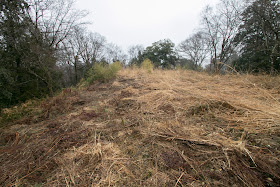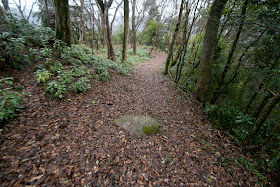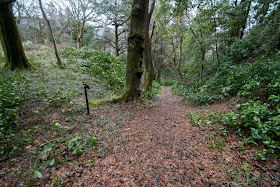Gohongadake Castle
-Castle has terraces alike winding stairs-
Overview
Name: Gohongadake castle (Gohongadake-jo)
Alias: Tojo-jo (Eastern castle)
Place: Tojo-cho Shobara city, Hiroshima
Location: 34.89600695300225, 133.2665888744275
Type: Mountain Castle
Built: 15th century
Remaining remnants: Stone walls and clay walls
Title:
Gohongadake castle (五品嶽城) is built at the top of Shiroyama mountain, one of about 150 meter height from hillside at the west edge of former Tojo town. Tojo area is a small valley locates at the northeastern edge of former Bingo province (eastern half of Hiroshima prefecture).
Tojo area is only three kilometer apart from the border, and an important place for border security. Also Tojo area had been a distribution center of river transportation by Takahashi-gawa river, and also a place of traditional iron production.
From past till now including Chugoku Jidoshado Expressway, the main route toward east and west in the mountainous area at the middle of Chugoku region is the one runs along tributaries of large rivers and changes to the another, which basically flow from Chugoku mountains toward Setonaikai sea. Tojo town exist at the upstream of Nariwa-gawa river which is a large tributary of Takanashi-gawa river, one of three large rivers of current Okayama prefecture. At the west of Tojo town, old road runs toward north and crosses to Saijo-gawa river, a tributary of Gonokawa river flows to Miyoshi area.
Precise year is unknown but Gohongadake castle was built by local lord Miya clan. The origin of Miya clan is also ambiguous, but it is said as a descendant of the family of priest of Kibitsu shrine of Bingo province. At first Miya clan had a territory at Uta area of Yamato province (Nara prefecture) under Kamakura Shogunate, but later achieved the territory at Bingo province and moved there.
At the fall of Kamakura Shogunate, Miya clan at first belonged to Emperor Godaigo (1288-1339) who ruined Kamakura Shogunate in cooperation with Takauji Ashikaga (1305-1358). But when Takauji left Emperor Godaigo and established his own Muromachi Shogunate, Miya clan followed Takauji and fought against Emperor side. Because of their contribution, Miya clan was treated as a direct retainer of Shogunate.
In Muromachi era, the governor of Bingo province were parachuted from Shogunate and frequently changed. Later Yamana clan continuously served as the governor, but the main territory of Yamana clan was Tajima province (north part of Hyogo prefecture) and far from Bingo province. Furthermore, Yamana clan significantly lost their power after the long battle of Onin. Because of these reasons, the dominance of governor was nominal, and strong local lords such as Yamauchi clan, Sugihara clan and Miya clan virtually managed the province.
At first Miya clan lived at Kamejuyama castle, in the northwestern part of current Fukuyama city near Sagata castle. The main family of Miya clan continued at there, but was ruined by Motonari Mouri (1497-1571), the warlord of Aki province (western half of Hiroshima prefecture) in 1540. But their relative survived under Mouri clan and later built Sagata castle, a modern castle built with stone walls.
On the other hand, Hisashiro Miya clan which was a branch family of Miya clan moved to north part of the province and increased their power there. At first Hisashiro Miya clan lived at Hitayama castle at mountainous area, but along with the expansion into Tojo area, they newly built Gohongadake castle as their main base. at the beginning of 16th century.
Furthermore, Miya clan expanded their territory toward west, for current Saijo area, and fiercely fought with Yamauchi clan at Kouyama castle of Shobara city. In 1533, Takamori Miya (?-?), the leader of Hisashiro Miya clan, newly built Omoriyama castle in the middle of Tojo area and Shobara castle as their main base and moved there. As Omoriyama castle located at the west of Gohongadake castle, Omoriyama castle was called as Saijo (western castle) and Gohongadake castle was said as Tojo (eastern castle).
Hisashiro Miya clan was feared as one of "Two Miya family of Bingo province". But when the power of Amago clan which was the warlord of Izumo province (Shimane prefecture) expanded into Bingo province, Hisashiro Miya clan followed Amago clan along with their main family and fought for them. However, after the rise of Motonari Mouri, different from their main family, Hisashiro Miya clan changed to Mouri clan and continued as their retainer.
But in 1591, Miya clan was transferred to Izumo province and ended its history at Bingo province. In exchange, Hirotada Sawa (?-?) who might be close to Takahide Sawa (?-1592), a local lord of Iwami province (western part of Shimane prefecture) who followed to Mouri clan, was appointed as a commander of Gohongadake castle.
In 1600, as a result of the battle of Sekigahara, Mouri clan lost major part of their territory including Bingo province. Masanori Fukushima (1561-1624) who activated both at prelude and main battle of Sekigahara, became the large lord of Aki province and Bingo province.
But new territory of Aki province and Bingo province was a wide territory separated into small basins by mountains. To protect his territory, Masanori needed branch castles at each area to gain time before the arrival of main army. Because of this reason, in addition to his main base Hiroshima castle, Masanori reformed or built six branch castles such as Kamei castle, Mihara castle, Ozekiyama castle, Gohongadake castle, Kannabe castle and Tomo castle at each border.
Gohongadake castle spreads over S curved ridge continues from hilltop to halfway. At the top of the mountain, there is a terrace named Tsunenomaru, equivalent to central area. This area is a rectangular one of 50 meter long and 20 meter wide, which has a stone built main tower basement at west edge. Just below of Tsunenomaru area, there is a terrace has a ruin of garden including miniature mountain and pond, which might be the ground for residence of the lord.
Next to these areas, terraces such as Taikononara, Keyakinonara or Kayanonara spreads along with curved ridge, like a winding stairs. These areas has a tall clay wall at its northern line, and their front side wall might protected by stone wall. In addition to these hilltop areas, there are several terraces such as Suginonara or Monomimaru at the entrance of climbing roads from hillside. Total length of the castle is about 200 meter, and a moderate one as a branch castle of strong warlord.
Masanori placed Kazukatsu Nagao (1550-1619), one of his three vassals, as the commander of Gohongadake castle. Kazukatsu. Kazukatsu was a veteran brave general activated at many battles, but also made effort to develop the castle town named Gohongadake castle as "Yonaoshi-jo" (reforming castle) to show his will.
But Fukushima clan lost its territory and was expelled in 1619, and Nagao clan was hired by Mori clan at Tsuyama castle (Okayama prefecture). Gohongadake castle was abolished at this time. but Asano clan which succeeded the territory of Fukushima clan also placed their branch family at Tojo town. The town prospered as a center of local commerce by the end of Edo era.
Now all building was lost and magnificent stone walls were also demolished at the time of abolishment. But structures of the castle like winding stairs well keep its form on the mountain. Its location near from Tojo interchange of Chugoku Jidoshado Expressway shows unchanged importance of Gohongadake castle. Many old building still remains at Tojo town, and the town keeps a nostalgic atmosphere same as the period of Gohongadake castle.
15 minutes walk from JR West Geibi-sen line Tojo station to hillside entrance at the backside of Yonaoshi Shrine. 10 minutes drive from Chugoku Jidoshado Expressway Tojo interchange to hillside parking. 30 minutes walk from hillside entrance to hilltop castle.
Sagata Castle -Stone walls on sheer cliff looking on valley-
Hiroshima Castle -Deviation from clan's tradition on castle-
Kamei Castle -Largest and strongest branch castle-
Mihara Castle -Naval base castle at Inland Sea-
Kannabe Castle -Six years in past and 10 minutes now-
Type: Mountain Castle
Built: 15th century
Remaining remnants: Stone walls and clay walls
Title:
Brief History
Gohongadake castle (五品嶽城) is built at the top of Shiroyama mountain, one of about 150 meter height from hillside at the west edge of former Tojo town. Tojo area is a small valley locates at the northeastern edge of former Bingo province (eastern half of Hiroshima prefecture).
Tojo area is only three kilometer apart from the border, and an important place for border security. Also Tojo area had been a distribution center of river transportation by Takahashi-gawa river, and also a place of traditional iron production.
From past till now including Chugoku Jidoshado Expressway, the main route toward east and west in the mountainous area at the middle of Chugoku region is the one runs along tributaries of large rivers and changes to the another, which basically flow from Chugoku mountains toward Setonaikai sea. Tojo town exist at the upstream of Nariwa-gawa river which is a large tributary of Takanashi-gawa river, one of three large rivers of current Okayama prefecture. At the west of Tojo town, old road runs toward north and crosses to Saijo-gawa river, a tributary of Gonokawa river flows to Miyoshi area.
Origin of Gohongadake castle and Miya clan
Precise year is unknown but Gohongadake castle was built by local lord Miya clan. The origin of Miya clan is also ambiguous, but it is said as a descendant of the family of priest of Kibitsu shrine of Bingo province. At first Miya clan had a territory at Uta area of Yamato province (Nara prefecture) under Kamakura Shogunate, but later achieved the territory at Bingo province and moved there.
At the fall of Kamakura Shogunate, Miya clan at first belonged to Emperor Godaigo (1288-1339) who ruined Kamakura Shogunate in cooperation with Takauji Ashikaga (1305-1358). But when Takauji left Emperor Godaigo and established his own Muromachi Shogunate, Miya clan followed Takauji and fought against Emperor side. Because of their contribution, Miya clan was treated as a direct retainer of Shogunate.
In Muromachi era, the governor of Bingo province were parachuted from Shogunate and frequently changed. Later Yamana clan continuously served as the governor, but the main territory of Yamana clan was Tajima province (north part of Hyogo prefecture) and far from Bingo province. Furthermore, Yamana clan significantly lost their power after the long battle of Onin. Because of these reasons, the dominance of governor was nominal, and strong local lords such as Yamauchi clan, Sugihara clan and Miya clan virtually managed the province.
East castle and west castle
At first Miya clan lived at Kamejuyama castle, in the northwestern part of current Fukuyama city near Sagata castle. The main family of Miya clan continued at there, but was ruined by Motonari Mouri (1497-1571), the warlord of Aki province (western half of Hiroshima prefecture) in 1540. But their relative survived under Mouri clan and later built Sagata castle, a modern castle built with stone walls.
On the other hand, Hisashiro Miya clan which was a branch family of Miya clan moved to north part of the province and increased their power there. At first Hisashiro Miya clan lived at Hitayama castle at mountainous area, but along with the expansion into Tojo area, they newly built Gohongadake castle as their main base. at the beginning of 16th century.
Furthermore, Miya clan expanded their territory toward west, for current Saijo area, and fiercely fought with Yamauchi clan at Kouyama castle of Shobara city. In 1533, Takamori Miya (?-?), the leader of Hisashiro Miya clan, newly built Omoriyama castle in the middle of Tojo area and Shobara castle as their main base and moved there. As Omoriyama castle located at the west of Gohongadake castle, Omoriyama castle was called as Saijo (western castle) and Gohongadake castle was said as Tojo (eastern castle).
Transition of holders
Hisashiro Miya clan was feared as one of "Two Miya family of Bingo province". But when the power of Amago clan which was the warlord of Izumo province (Shimane prefecture) expanded into Bingo province, Hisashiro Miya clan followed Amago clan along with their main family and fought for them. However, after the rise of Motonari Mouri, different from their main family, Hisashiro Miya clan changed to Mouri clan and continued as their retainer.
But in 1591, Miya clan was transferred to Izumo province and ended its history at Bingo province. In exchange, Hirotada Sawa (?-?) who might be close to Takahide Sawa (?-1592), a local lord of Iwami province (western part of Shimane prefecture) who followed to Mouri clan, was appointed as a commander of Gohongadake castle.
In 1600, as a result of the battle of Sekigahara, Mouri clan lost major part of their territory including Bingo province. Masanori Fukushima (1561-1624) who activated both at prelude and main battle of Sekigahara, became the large lord of Aki province and Bingo province.
Structure of Gohongadake castle
But new territory of Aki province and Bingo province was a wide territory separated into small basins by mountains. To protect his territory, Masanori needed branch castles at each area to gain time before the arrival of main army. Because of this reason, in addition to his main base Hiroshima castle, Masanori reformed or built six branch castles such as Kamei castle, Mihara castle, Ozekiyama castle, Gohongadake castle, Kannabe castle and Tomo castle at each border.
Gohongadake castle spreads over S curved ridge continues from hilltop to halfway. At the top of the mountain, there is a terrace named Tsunenomaru, equivalent to central area. This area is a rectangular one of 50 meter long and 20 meter wide, which has a stone built main tower basement at west edge. Just below of Tsunenomaru area, there is a terrace has a ruin of garden including miniature mountain and pond, which might be the ground for residence of the lord.
Next to these areas, terraces such as Taikononara, Keyakinonara or Kayanonara spreads along with curved ridge, like a winding stairs. These areas has a tall clay wall at its northern line, and their front side wall might protected by stone wall. In addition to these hilltop areas, there are several terraces such as Suginonara or Monomimaru at the entrance of climbing roads from hillside. Total length of the castle is about 200 meter, and a moderate one as a branch castle of strong warlord.
Afterward of castle
Masanori placed Kazukatsu Nagao (1550-1619), one of his three vassals, as the commander of Gohongadake castle. Kazukatsu. Kazukatsu was a veteran brave general activated at many battles, but also made effort to develop the castle town named Gohongadake castle as "Yonaoshi-jo" (reforming castle) to show his will.
But Fukushima clan lost its territory and was expelled in 1619, and Nagao clan was hired by Mori clan at Tsuyama castle (Okayama prefecture). Gohongadake castle was abolished at this time. but Asano clan which succeeded the territory of Fukushima clan also placed their branch family at Tojo town. The town prospered as a center of local commerce by the end of Edo era.
Now all building was lost and magnificent stone walls were also demolished at the time of abolishment. But structures of the castle like winding stairs well keep its form on the mountain. Its location near from Tojo interchange of Chugoku Jidoshado Expressway shows unchanged importance of Gohongadake castle. Many old building still remains at Tojo town, and the town keeps a nostalgic atmosphere same as the period of Gohongadake castle.
Access
15 minutes walk from JR West Geibi-sen line Tojo station to hillside entrance at the backside of Yonaoshi Shrine. 10 minutes drive from Chugoku Jidoshado Expressway Tojo interchange to hillside parking. 30 minutes walk from hillside entrance to hilltop castle.
Related Castles
Sagata Castle -Stone walls on sheer cliff looking on valley-
Hiroshima Castle -Deviation from clan's tradition on castle-
Kamei Castle -Largest and strongest branch castle-
Mihara Castle -Naval base castle at Inland Sea-
Kannabe Castle -Six years in past and 10 minutes now-





































































































































































No comments:
Post a Comment